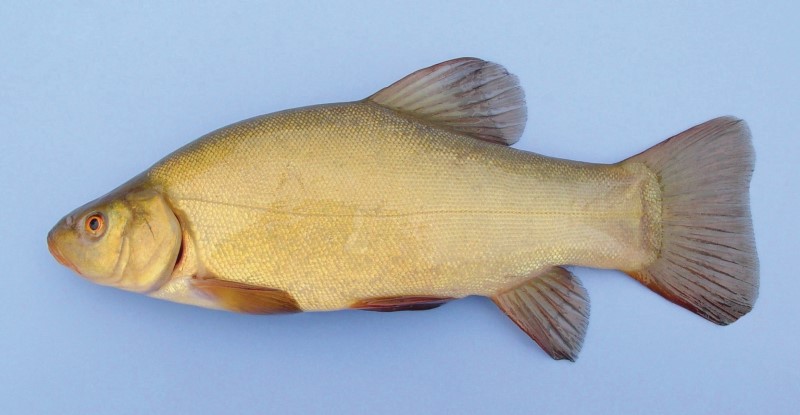Tench (Tinca tinca) - Introduced

A 9-inch tench from Bantam Lake, Morris.
Identification. Similar to common carp. Deep-bodied. Very small, deeply embedded scales (over 100 along midline). Thick caudal peduncle. Very slimy. Single barbel at corner of mouth. First major ray of dorsal fin spine-like. Soft dorsal rays 8-9. Soft anal rays 6-8. Tail fin shallowly concave. Back olive to brown fading to lighter brown to bronze on the sides and belly. Occasionally very dark, almost black. Eye orange to red.
Size. Commonly 8 to 16 inches. State survey max. size 19 inches. Max. reported size 33 inches.
Distribution. Native to Eurasia. Introduced in scattered areas of North America. Historically, the only known tench population in Connecticut was in Lake Winnemaug (Watertown, black triangle on map),which was first reported in 1942. More recently, a population has become established and is expanding in Bantam Lake (Morris, red triangles on map).

Habits. Prefer lakes and ponds with muddy bottoms and ample vegetation. Tench can be caught near the bottom on small hooks with such baits as worms or dough balls. They can be kept in home aquariums, but are shy and take time to acclimate. They eat a variety of food off the bottom, but quickly outgrow all but the largest tanks.

Where they become established, it is unclear what effects tench will have on other species.
Comments. A highly esteemed food and sport fish in Europe. The potential effects of tench on resident fish populations in Connecticut are unclear. Bantam Lake tench probably came from Lake Winnemaug. When Lake Winnemaug was drained in the mid-1990s, the fish population was “saved” by moving stranded fish to Bantam Lake. Negative environmental consequences are often not considered when people embark on these otherwise well-intentioned efforts. The tench and other fish populations in Bantam Lake are being closely monitored by the DEEP Fisheries Division.
Text and images adapted from Jacobs, R. P., O'Donnell, E. B., and Connecticut DEEP. (2009). A Pictorial Guide to Freshwater Fishes of Connecticut. Hartford, CT. Available for purchase at the DEEP Store. The fish distribution maps were created in 2009. For updated fish distributions please use the CT DEEP Fish Community Data Interactive Map.

